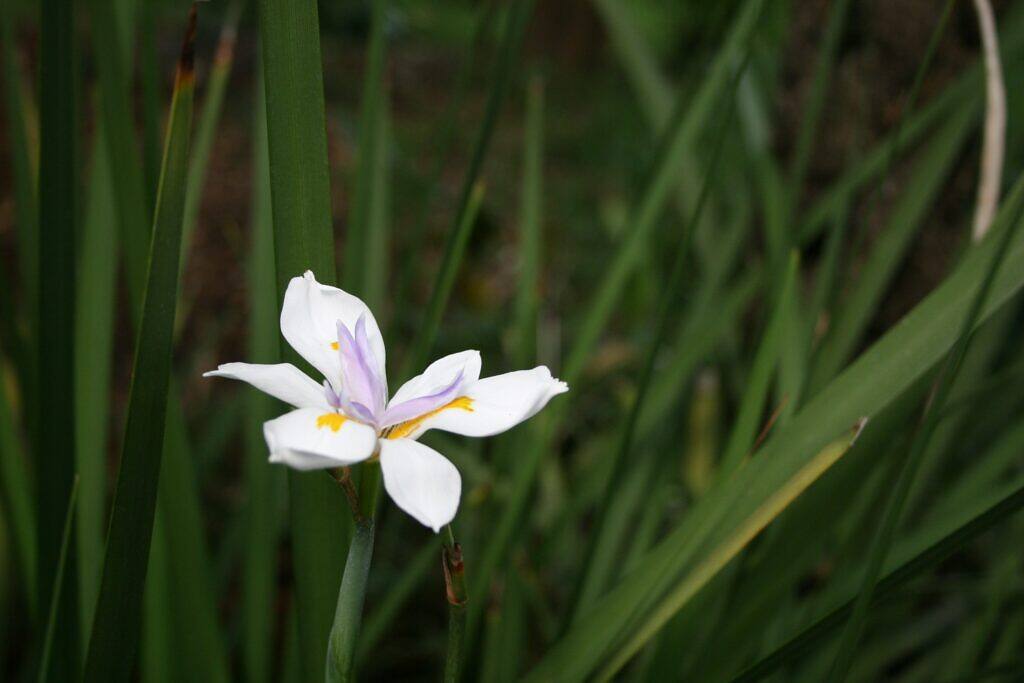The Fortnight Lily (Dietes iridioides), also known as Wild Iris, is an elegantly flowering plant that has won over landscapers and gardeners around the world for one simple reason: it thrives and requires low maintenance where many others fail or need constant replacements. Its white flowers with a golden center emerge continuously throughout various seasons, creating a visual spectacle that constantly renews itself. This perennial plant adapts well to both formal gardens and naturalized spaces, serving as a structural border, ground cover under trees, or as the main feature in flower beds.
Its resilience is impressive: it tolerates climatic variations, requires little water, and practically maintains itself. Therefore, it has become a recurring choice in landscaping projects in Brazil, South Africa, the United States, Australia, and Mediterranean regions such as Spain and Portugal. The genus name Dietes is derived from Greek and means “with two relatives,” a reference to its evolutionary relationship with the genera Iris and Moraea. The epithet iridioides means “similar to iris,” confirming the morphological resemblance that even confuses experienced observers.
Popular nomenclature often causes confusion among different garden Fortnight Lilies such as Dietes grandiflora and Dietes bicolor, but these belong to different species within the same genus, with D. grandiflora featuring larger flowers and D. bicolor with yellow flowers.
This species carries symbolism linked to resilience and renewal due to its ability to bloom repeatedly throughout the year, with blooms appearing at regular intervals of approximately fifteen days—a characteristic that earned it the common name of “Fortnight Lily”. Additionally, its ephemeral flowers, which last only a day but are quickly replaced by new ones, evoke the idea of constant renewal in nature.
Dietes iridioides is native to Eastern and Southern Africa, occurring from Ethiopia to South Africa. It naturally develops in ecosystems of open undergrowth, forest edges, and moist savanna areas, preferring locations with partial shade provided by tall trees. The typical environment includes well-drained soils and alternating periods of moisture and dryness. Its distribution covers countries such as Ethiopia, Kenya, Tanzania, Mozambique, Zimbabwe, and the entire southeastern coast of South Africa.
The Fortnight Lily is a perennial herbaceous plant, belonging to the Iridaceae family. It has a medium size, generally reaching between 16 and 24 inches (40 and 60 centimeters) in height and forming clumps with a width of 12 to 24 inches (30 to 60 centimeters). The root system is fasciculated, typical of monocots, with short, branched rhizomes that promote the formation of dense basal masses. The stems are sarmentose, erect or arched, thin, light green to greenish in color, with a smooth surface and reduced diameter. The growth is vigorous and branching occurs mainly at the base, resulting in fan-shaped groupings that expand laterally over time.
The leaves of Dietes iridioides are linear, long, and narrow, like swords, arranged in dense, overlapping basal fans. They have an intense dark green color and emerge directly from the rhizome. The leaf blades have well-marked parallel veins, entire edges, and a sharp apex; the length varies between 16 and 28 inches (40 and 70 centimeters) and the width between 0.4 and 0.8 inches (1 and 2 centimeters). These are persistent (perennial) leaves, remaining green throughout the year under suitable conditions. The texture is rigid and leathery, with a smooth and slightly glossy surface.

The Fortnight Lily is a monoecious species, featuring hermaphroditic flowers gathered in terminal inflorescences of the branched scape type. Flowering occurs mainly in spring, summer, and autumn, and can extend throughout the year in mild climates. The inflorescences rise above the foliage and bear solitary flowers or small clusters; each flower has radial symmetry (actinomorphic), with six free tepals—three outer white ones with central yellow spots and three smaller inner ones with violet details. The flowers are about 2.4 to 3.1 inches (6 to 8 centimeters) in diameter and are ephemeral, lasting only one day each; however, new buds continuously open on the same floral scape.
Pollination is primarily carried out by insects (entomophily). The fruit is an elongated capsule, greenish to brown when mature, inedible and of no ornamental importance; it is dehiscent and upon opening releases small, brown or black seeds, oval to ellipsoidal in shape. Seed dispersal occurs through gravity (barochory), often aided by the inclination of the scapes towards the ground after the fruit has matured.
In landscaping, the Fortnight Lily is valued for its dense clumps of dark green, fan-shaped foliage, serving as an excellent option for ground cover or borders in flower beds. Its adaptation to different soil types and drought tolerance after establishment make it particularly useful in sustainable and low-maintenance projects. It is often used as ground cover under tall shrubs or open trees, creating an ornamental carpet that inhibits the growth of invasive plants and adds texture to the garden. Due to its dense clumping habit, it is also an excellent choice for sloped areas or embankments.
The Fortnight Lily can be grown in large pots for balconies or well-lit indoor areas, although full flowering development preferably occurs under direct sunlight or partial outdoor shade. Its medium size—between 16 inches and 24 inches (40 cm and 60 cm)—allows for compositions with ornamental grasses, African Lilies (Agapanthus spp.), daylilies (Hemerocallis spp.) and other perennial herbs. The elevated white inflorescences stand out above the rigid, dark, and narrow foliage, providing an interesting visual contrast.
The Fortnight Lily can serve as a focal element in contemporary, formal, informal, or tropical gardens thanks to the elegance of its white flowers with a yellow center and violet details. Used in large groups or continuous rows, it creates a striking bouquet effect when grown en masse. Its characteristics facilitate its use as a discreet visual barrier along walls or pathways. Beyond its ornamental appeal in the garden, the species attracts pollinators such as bees and beneficial insects to the local ecosystem.
The Fortnight Lily prefers full sun environments but also tolerates partial shade, especially under the canopies of tall trees that provide abundant filtered light. It is suitable for regions with subtropical, tropical to Mediterranean climates, adapting well to temperatures between 50°F and 82°F (10°C and 28°C). It resists light frosts but may suffer damage during intense and prolonged cold episodes. It tolerates moderate winds, but excessively exposed locations can impair foliage vigor. It shows good adaptation to maritime conditions, being appropriate for coastal gardens, provided it is protected from extreme salinity.
Fortnight Lily prefers sandy-clay or light clay soils with good drainage and moderate fertility, avoiding compacted or waterlogged substrates. The ideal pH ranges from 6.0 to 7.0 (6.0 to 7.0). In pots, it is recommended to use a universal potting mix enriched with organic matter and perlite or coarse sand to ensure efficient drainage. Watering should be regular during the establishment of the seedlings, keeping the soil slightly moist without waterlogging. After full rooting, Fortnight Lily tolerates short periods of drought and has its water needs reduced. Excess water promotes diseases such as root and rhizome rot and rust; therefore, avoid poorly drained soils. In areas with poor drainage, prefer planting in raised beds.
Planting should be done in planting beds and spaced according to the desired size of the massif (12 to 16 inches (30 to 40 cm) between plants). Annual fertilization at the end of winter with well-rotted cow manure or organic compost is recommended to stimulate sprouting and flowering. Pruning is limited to the periodic removal of dry or damaged leaves and cutting of flower stalks and fruits after flowering ends to stimulate new shoots. The application of mulch around the base helps maintain soil moisture and control invasive plants.
Fortnight Lily shows high resistance to most pests and diseases common in ornamental gardens. It may occasionally be affected by root rot in waterlogged soils and rust in very humid conditions; in these cases, it is recommended to improve drainage and remove affected parts. Severe insect attacks are rare, although slugs and snails may occasionally be bothersome. Periodic monitoring is sufficient to keep the plant healthy.
The most efficient propagation is carried out by division of adult clumps during late winter or early spring, carefully separating segments of the rhizome with active roots and preserved leaves; each seedling should contain at least one healthy vegetative point (a fan of leaves). Immediate planting favors rapid recovery and establishment in the new location. It is also possible to multiply by seeds collected from ripe fruits, but this method results in a longer time until initial flowering (usually two to three years). It is common for the plant to self-seed naturally, spreading beyond the desired extent. By dividing well-developed clumps, new plants can bloom as early as the next season after transplanting.





